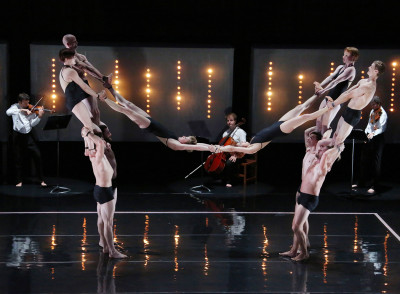
With poise and unbelievable strength, 14 acrobats used their bodies to twist, flip, fly and illustrate the music of Russian composer Dmitri Shostakovich in performances of Circa’s “Opus” Friday through Sunday at Citi Shubert Theatre.
Directed by Yaron Lifschitz and presented by the Celebrity Series of Boston, “Opus” integrates music performed by the Debussy String Quartet, a group based in Lyon, France, with aerial stunts and lyrical movements.
Started in 2004, Circa is a circus arts performance troupe based in Brisbane, Australia. The company features an ensemble of talented artists and acrobats who perform in shows that have been seen in over 33 countries across six continents.
“Circa work has a high degree of virtuosity,” said Lifschitz, CEO and artistic director of Circa. “It carries [as] raw, emotionally packed on the audience and I think that’s how our shows work.”
Gary Dunning, president and executive director of the Celebrity Series of Boston, also said he believes the troupe offers a high level of virtuosity.
“Circa may be based on circus arts, but it’s not remotely about, ‘let me show you one trick after another,’” he said. “It is deeply, authentically artistic with a point of view about the music and about how they want to present their art form.”
“Opus” premiered June 19, 2013 at the Les Nuits de Fourvière Festival in Lyon. Over the past two and a half years, the show has been performed in France, Spain, Australia, Germany, Luxembourg, the United Kingdom and the United States. The three showings in Boston mark the end of the show’s U.S. tour.
The show began with a moment of silence for those killed and injured in the most recent Paris terrorist attacks were remembered. The entire performance was also dedicated to the victims.
As the curtains rose, the quartet serenaded a solo performer suspended on a rope with Shostakovich’s “Adagio (Elegy) for String Quartet.” The show progressed rapidly into a combination of intrinsic movements, nail-biting flips and incredible group acrobatics.
While not much of a narrative, but rather an interpretation of Shostakovich’s emotionally charged work, the show saw a progression from piece to piece.
This emotional progression was reflected in the three costume changes as well. Over the course of the show, the performers change from black to blue clothes, and then into simplistic uniforms.
“In the beginning, I reference a funeral in the design colors — death, grief and mourning,” said Libby McDonnell, creative associate of Circa and costume designer for “Opus.” “When the color palette changes to the gray and steel blue, the design becomes more political and also more human. Then finally, the most acrobatic friendly costume in the fifth quartet is the black leotards and bike shorts. This was to completely expose their bodies in a raw, seething mass of human flesh, bruises and muscles, everything.”
While reflecting on the tone of the music, McDonnell said “Opus” is both political and personal.
“Through use of repetition, I have politicized the design in terms of mass production and making the artists at times homogenous, making it visually challenging for the individual to appear from the masses,” she said.
Start-to-finish, the show impressed, stunned and startled audience members. A collective gasp was heard throughout the theater during the most dangerous stunts. One incredible moment included an acrobat doing the splits while performing on aerial silks, many feet in the air and no net beneath her. In another moment, a performer carried three other acrobats at one time, demonstrating the incredible amount of strength necessary to perform these skills.
Dunning said he was most captivated by the “deeper, emotional content of the show” and interaction between the quartet members and acrobats. An example of this seamless integration occurred when performers blindfolded the instrumentalists and led them to various places on stage.
“To find a string quartet that can play at this level, but who has also integrated themselves into the performance and into the movement and the trust level that exists between all the performers on stage … that’s pretty special,” he said.
Julia Braverman, 40, of Needham, said she enjoyed the part of the performance where an acrobat spun multiple hula hoops around her entire body. Braverman also said she enjoyed it when “the music stopped all of a sudden” and the performers surrounding the acrobat reached out and grabbed a hula hoop in perfect synchronization.
Slava Gerovitch, 51, of Natick, said he felt the acrobatics added a whole new layer to the perception of music, and thought “every gesture was both technically amazing and symbolically laden.”















Excellent article! I wish I could have seen the show. It sounds like it was amazing to watch.